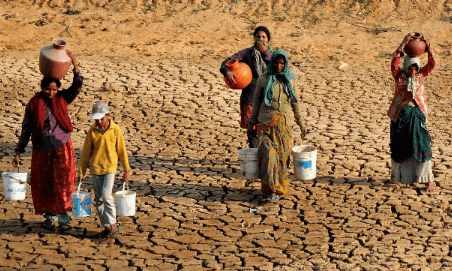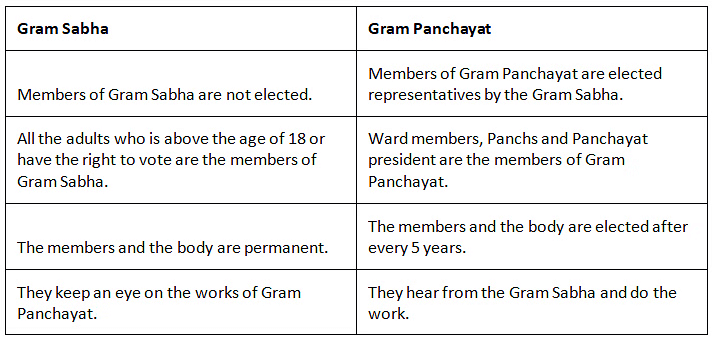NCERT Solutions for Class 6 Civics - Panchayati Raj
Q1. What problem did the villagers in Hardas village face? What did they do to solve this problem?
Ans: Problem faced by the villagers in Hardas village:

- Acute water shortage.
- Hand pump water has gone well below the point up to which the ground has been drilled.
- Women have to go to the Suru river which is 3 k.m. away to get water.
Solutions implemented by the villagers:
- Piped water from the Suru River and built an overhead tank in the village.
- Deepened hand pumps and cleaned wells for the current season.
- Developed a long-term solution for water conservation through watershed development.
Q2. What, in your opinion, is the importance of the Gram Sabha? Do you think all members should attend Gram Sabha meetings? Why?
Ans: Importance of Gram Sabha:
- The Gram Sabha elects members of the Gram Panchayat.
- It can question the Gram Panchayat and monitor their activities.
- Local issues affecting villagers can be discussed during meetings.
- Solutions to these problems can be recommended.
Yes, all members should attend Gram Sabha meetings because:
- They can raise daily issues they encounter.
- They can provide feedback on the work done by the Gram Panchayat.
- It serves as a platform to discuss village welfare programmes.
Q3. What is the link between a Gram Sabha and a Gram Panchayat?
Ans: Link between a Gram Sabha and a Gram Panchayat:
- The Gram Sabha elects the members of the Gram Panchayat.
- The Panch and the Gram Panchayat are accountable to the members of the Gram Sabha.
- The Gram Sabha monitors the actions of the elected representatives in the Gram Panchayat.

Q4. Take an example of any one task done by a Panchayat in your area/ nearby rural area and find out the following:
(a) Why it was taken up.
(b) Where the money came from.
(c) Whether or not the work has been completed.
Ans: (a) The Panchayat needs to construct a building for the middle school.
(b) A major part of the money came from the State Government, and a minor part of the money came from the funds of the Panchayat.
(c) The work has been completed on time.
Q5. What is the difference between a Gram Sabha and a Gram Panchayat?
Ans:  Q6. Read the following news item. Nimone is a village on the Chauphula-Shirur Road. Like many others, this village has also been facing a severe water shortage for the last few months and villagers depend on tankers for all their needs. Bhagvan Mahadeo Lad (35) of this village was beaten with sticks, iron rods and axes by a group of seven men. The incident came to light when some villagers brought a badly injured Lad to hospital for treatment. In the FIR recorded by the police Lad said that he was attacked when he insisted that the water in the tanker must be emptied into the storage tanks constructed as part of the water supply scheme by Nimone Gram Panchayat so that there would be equal distribution of water. However, he alleged that the upper caste men were against this and told him that the tanker water was not meant for the lower castes.
Q6. Read the following news item. Nimone is a village on the Chauphula-Shirur Road. Like many others, this village has also been facing a severe water shortage for the last few months and villagers depend on tankers for all their needs. Bhagvan Mahadeo Lad (35) of this village was beaten with sticks, iron rods and axes by a group of seven men. The incident came to light when some villagers brought a badly injured Lad to hospital for treatment. In the FIR recorded by the police Lad said that he was attacked when he insisted that the water in the tanker must be emptied into the storage tanks constructed as part of the water supply scheme by Nimone Gram Panchayat so that there would be equal distribution of water. However, he alleged that the upper caste men were against this and told him that the tanker water was not meant for the lower castes.
(a) Why was Bhagvan beaten?
(b) Do you think that the above is a case of discrimination? Why?
Ans:
(a) Bhagvan was beaten when he insisted that the water from the tanker should be emptied into the storage tanks built by the Nimone Gram Panchayat as part of the water supply scheme, so everyone would get an equal share of water.
(b) Yes, this is a clear case of discrimination. The water was not distributed equally; it was only provided to upper-caste individuals. Lower-caste people were excluded from receiving water. The tanker water was not emptied into the tank meant for equal distribution.
Q7. Find out more about watershed development and how it benefits an area?
Ans: Watershed development focuses on the conservation, recharging, and careful use of water resources, including underground water, rivers, and land within a watershed area.
Benefits of watershed development include:
- Increased fertility: It enhances soil fertility, promoting the growth of trees, plants, and crops.
- Water preservation: It helps in conserving water and its resources.
- Soil protection: It prevents soil erosion, maintaining land integrity.
|
297 videos|1066 docs|204 tests
|
FAQs on NCERT Solutions for Class 6 Civics - Panchayati Raj
| 1. पंचायती राज क्या है? |  |
| 2. पंचायती राज के क्या लाभ हैं? |  |
| 3. ग्राम पंचायत के कार्य क्या होते हैं? |  |
| 4. पंचायती राज में चुनाव प्रक्रिया कैसे होती है? |  |
| 5. पंचायती राज के विभिन्न स्तरों में क्या अंतर है? |  |






















